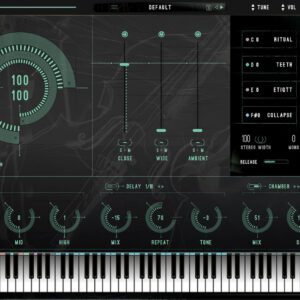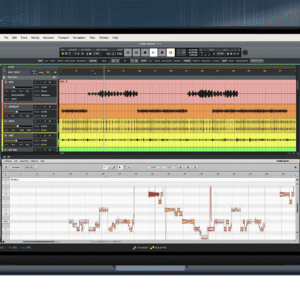We only recommend products that we use and believe in. When you purchase through links on our site, we may earn an affiliate commission.
2011 Marks the 20th Anniversary of Pro Tools Software.
Avid surprised many at the 2011 AES with the introduction of Pro Tools 10 in less than a year after the ground-breaking release of Pro Tools 9 Native.
Pro Tools 10 represents a quantum leap in quality and functionality that has been in development for the last two years. David Gould of Avid demonstrated some of the 44 new features of Pro Tools 10 on an Alicia Keys track before a packed house at the special AES press event. Available now as an upgrade from Pro Tools 9 for $299, $699 for a new copy and Pro Tools|HDX systems starting just under $10,000. HDX will support RTAS, AudioSuite and the new HDX plug-ins (Both native and DSP) and has a .7ms latency with an HD Series I/O. The file system in PT10 has been re-written with a ram cache for quicker access to audio files so that it is “much, much faster to open and access sessions”.
New Features Include:
32 bit Floating Files
Real-Time Editing
Channel Strip Plugin
AAX Plugins – A new format with over 50 plugins available now from 3rd party developers. TDM plugins don’t work on the HDX system but they still work on TDM systems. Eventually AAX will replace RTAS and TDM.
Pro Tools|HDX
The Pro Tools|HDX system enables customers to mix bigger, more complex productions, with the rock-solid performance and stability that Pro Tools|HD customers have come to expect.
This new system represents a milestone in Avid’s development of DSP-accelerated hardware, delivering up to 5x more DSP per card, over a thousand dB of additional headroom, and up to 4x the track counts and 2x the I/O compared to its Pro Tools|HD Accel predecessor.
Crossgrades are available for LE and M-Powered, the $299 upgrade pricing is for Pro Tools 9 customers upgrading to Pro Tools 10. October 1st is the amnesty date for a free upgrade.
Pro Tools timeline of releases
- 1989 – Sound Tools stereo recording & editing system
- 1991 – Original Pro Tools system is released featuring 4 voices, ProDECK and ProEDIT software, MIDI, and automation
- 1993 – Pro Tools 2.0, provides 4-16 voices
- 1994 – Pro Tools III system, provides 16–48 voices
- 1997 – Pro Tools | 24 (24-bit audio, 32-64 voices)
- 1998 – Pro Tools | 24 MIX (expanded DSP capabilities for mixing audio)
- 1999 – Pro Tools 5.0 (integrated MIDI sequencing); Digi 001 with Pro Tools LE (Limited Edition of Pro Tools)
- 2000 – Pro Tools Free (8 audio tracks, 48 midi tracks), later discontinued
- 2002 – Pro Tools | HD system (supports 96 kHz and 192 kHz HD audio); Mbox and Digi 002 (March and Sept.)
- 2003 – Pro Tools | HD Accel system (additional DSP capabilities); Pro Tools 6.0 (supports Mac OS X); Pro Tools Users group founded in Los Angeles.
- 2004 – ICON D-Control (combines tactile control surface and a Pro Tools | HD Accel system in one unit)
- 2005 – VENUE (Pro Tools for live sound); Mbox 2; Pro Tools M-Powered (Aug); Pro Tools 7.0 (Nov), 7.1 (supports Apple’s PCIe G5) (Dec.) Avid acquire Wizoo and announce the creation of AIR (Advanced Instrument Group) as a strategic development arm of Avid, creating virtual instruments and plug-ins for use in Pro Tools.
- 2006 – Pro Tools 7.2 (Aug.) and 7.3 (Dec.); Pro Tools LE and HD support Intel-based Mac (May and Sept. respectively); Mbox 2 Pro;Mbox 2 Mini
- 2007 – 003 and 003 Rack (Feb.); Mbox 2 Micro (Oct.); Pro Tools 7.4 (Nov.) (Elastic Audio)
- 2008 – Pro Tools 8 (Elastic Pitch, Score Editor, MIDI Tools); 003 Rack +
- 2009 – Pro Tools Essential (Limited track count for starter market); “Eleven Rack“(Guitar effects processor and Pro Tools LE DSP accelerated interface)
- 2010 – Pro Tools Mbox Mini, Pro Tools Mbox , Pro Tools Mbox Pro (Third Generation, first full release by Avid), Pro Tools HD 8.1,Instrument Expansion Pack, Pro Tools HD Series Interfaces (HD I/O, HD OMNI, HD MADI, SYNC HD and PRE); Pro Tools HD Native, Pro Tools 9 (hardware independent)
- 2011 – Avid releases Pro Tools 9, breaking down the wall between LE and HD with end of LE versions. The new ability to use the software without using an Avid specific interface – it can run from an iLok.








